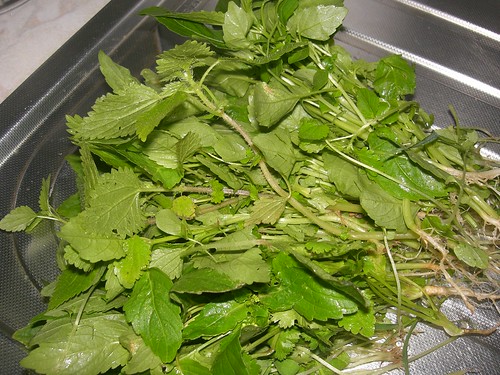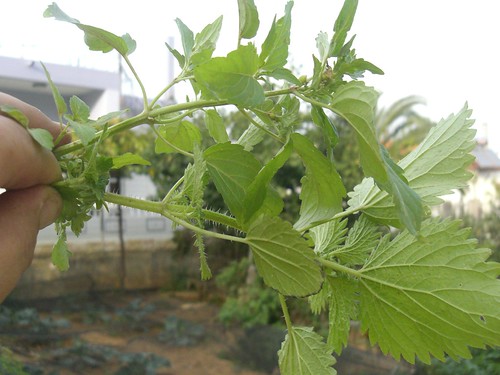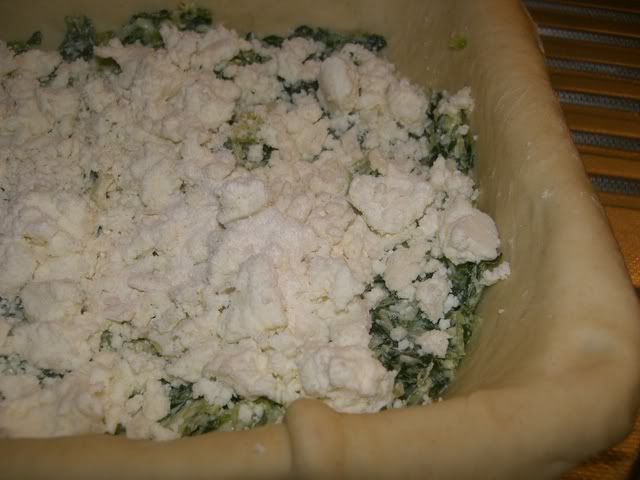Yesterday I did something that I wouldn't recommend anyone do without thinking of the risks involved first: I added an unidentified plant from the garden to my cooking.
Spurred on by the economic crisis and the fact that only about a fraction of the plant species in the world have been used as food, I decided that there can't be any harm in trying a new one, or at least one which is not commonly used in our cooking, but is prevalent in all the fields and gardens of the province, and is also known to be an edible plant species: nettles.
Nettles are those nasty stinging plants which cause an itchy sensation wherever they touch human skin. Most people would probably not know that they are edible, although I remember once my father bringing them home in our apartment in Hania, telling me that they are good for lowering blood pressure which he suffered from. (Pity he didn't just stick to eating this instead of getting involved with other blood-pressure lowering activities.) His sister had boiled them, so they resembled green mush. They looked very off-putting, but are apparently very nutritious: "Stinging nettle has a flavor similar to spinach when cooked, and is rich in vitamins A, C, D, iron, potassium, manganese, and calcium."

(one stings, the other doesn't; they look similar, despite the age difference - the stinging plant looks younger than the non-stinging one)
I knew that they would feel prickly, so I came prepared with some protective gloves to harvest them from the garden. But I was surprised when I couldn't see many thistles on them as I was picking them. I realised that there were two weeds growing side by side that looked exactly the same: one had stinging hairs on the stems and leaves,while the other was completely bald, but the shape of leaves and the general form of the weed seemed no different to each other. I decided to check out all the information available on nettles over the internet.
Wikipedia, usually our first choice for encyclopaedia-style information, tells us that most nettle species "share the property of having stinging hairs, and can be expected to have very similar medicinal uses to the stinging nettle." Possibly, the hairless species I found was also a nettle but not a stinging one. But the question is, are they edible too?
I finally found a reference for this non-stinging variety, but not before I added them to my latest kalitsounia and "spinach" pie making stint. I chopped the nettles in the same way that I would chop spinach and add it to a pie filling. I also tried the pie filling before cooking it, as well as after it came out of the oven. There was no discernible flavour that made the kalitsounia or pie taste different from what my family would normally eat as I cook it. The nettles - with and without sting - did not have any particular flavour in the first place, which makes me wonder whether makers of mass-produced spanakopita, my favorite takeaway, use nettles in their pie-fillings: they are much cheaper than spinach, although they may be harder to work with. But do not despair: blanching nettles removes their sting.
My non-stinging species was probably the wood nettle. Here's what WildManSteveBrill says about them:
"Other true nettle species are also edible. You'd think the stinging hairs would make nettle identification easy. Nevertheless, I once ran into some people in the woods who insisted that clearweed (Pilea pumila), a similar-looking, nonpoisonous plant with a translucent stem and no stinging hairs, was stinging nettles. They had been eating this unpalatably inedible nontoxic plant, which I had always rejected as unpalatable, all summer."
The kalitsounia were a complete success with the whole family - the contents of the tin disappeared as soon as I brought it out of the oven (hence no photos!), with no adverse side-effects. I had some remaining mixture which I made into a small pie for the deep freeze, using Laurie's ladenia pizza dough as a base. The family was informed about the nettles after they had eaten. The question is whether I would use nettles again in a meal, to compensate for a lack of organic leafy greens, and the answer is, yes, I would. Nettles don't seem to taste too different from any other grassy leaves; some people claim that they taste like spinach when cooked. When they are mixed into other ingredients such as soft cheese and other herbs (for a hortopita pie filling), they will go by completely unnoticed. However, I don't think I would use them on their own; they are simply too unpalatable-looking...
This is my entry for Kalyn's Weekend Herb Blogging, hosted this week by Laurie from Mediterranean Cooking in Alaska, who's tasted far less conventional greenery than the mere nettle: you should see what she did with spruce and pine tips.
©All Rights Reserved/Organically cooked. No part of this blog may be reproduced and/or copied by any means without prior consent from Maria Verivaki.




wow. :O impressive that you had the confidence to add it to your cooking. and i'm glad they liked it. :)
ReplyDeletepeople in romanian villages have been picking and eating nettle (the stinging variety) for many may years. And they do not always use gloves when picking maybe there is a trick involved :) (or they are just hardy). they make it like spinach puree and/or drink the liquid in which they have boiled nettle - for some curative/or preventive benefit.good luck with your culinary adventures!
ReplyDelete(one well read/educated greek lady told me that there are very few greens we people cannot eat.)
Oh what an interesting post on nettles. I made the mistake of taking a leaf raw to taste it and had stings on my lips to show for it. I'm fascinated by these lesser-known plants, so thanks for sharing this.
ReplyDeleteYou know, we're definitely on the same wavelength. I was just on the phone telling my husband that our daughter fell to the nettles in the garden, how she was crying because her arms were covered in stings. Anyway, shortly that I said, "you know that they're edible don't you?"...and then we discussed using them in my cooking. How timely of you! :)Great post and great information.
ReplyDeleteI've heard of "pites" being made with nettles and now I see it. Very resourceful of you.
ReplyDeleteThere are also soup recipes for stinging nettles.
I've heard of stinging nettles, but I've never seen one until viewing your photos. I've heard that if you brew them as if for tea, they are great for seasonal allergies.
ReplyDeleteI love nettle pie but was never brave enough to make one. You give me strength, plus there are so many free nettles all around me!
ReplyDeleteYou know, each time I read an entry in your blog, I get goose pimples. Just too many memories from my childhood visiting my Grandmother in Xania coming back.
ReplyDeleteCalitsounia for one - my Grandmother used to cook these all the time. Specifically ones filled with Mizithra (a tangy goats cheese ricotta - can't seem to find it outside of crete), shallow fried in olive oil, then drizzled with sweet honey from our cousins who used to have bee hives.
To add to that, looking at the other link you posted, you are the only other person i've come across who even KNOWS someone with the same name as my mother - Zampia. From what I understand it is a very traditional Cretan (perhaps even specific to Hania) name which one doesn't come across often these days.
Oh, and by the way - Nettles are delicious. Nettle tea is very soothing.
I usually buy my nettle tea from the health shop, but I understand you can take young shoots and just steep them in hot water for several minutes. It is usually drunk without milk.
ReplyDeleteI've never been brave enough to forage for food here in the UK except for blackberries - even though nettles are abundant. I might try that though. Do you know if they are OK to eat once they have gone to flower?
My mom never celebrated a name day - and neither have I. Bit of a bummer really - I always like an excuse to have a party :-)
Interesting blog about Organic foods Nettle leaves sound like unique and healthy greens.
ReplyDeleteAs I understand it, nettles lower blood pressure by being a natural diuretic (ie they make you wee!). Being a bit worried about my blood pressure a while back I bought some nettle tea, which I have to say was the most revolting drink I think I have ever had in my life! I'd be happy to have the leaves cooked, but I won't be having nettle tea again any time soon!
ReplyDeleteVery interesting and resourceful! I've eaten dandilion leaves but thats about all from the yard.
ReplyDeleteNow that is strange, nettles only grow in my garden in spring in Melbourne. In fact they are now going to seed and are about to die off. This year I've drunk the fresh nettle tea for hayfever.
ReplyDeleteLast year I started eating it too. My favourite was a tortilla/omelette which I blogged about here:
http://confessionsofafoodnazi.blogspot.com/2007/08/whb95-tortilla-with-sting.html
I've noticed my local farmers markets now sell bunches of nettles as a gourmet treat, in season late winter to early spring. They always sell out fast.
I absolutely love nettles, they're one of my favorite greens. For one thing, they are super easy to clean and as you say they have a nice mild flavor. One thing to know about gathering nettles is to only use them when they are young. Older nettles contain crystalline particles called cystoliths that are bad for the kidneys. Anyway, I'm glad you tried them!
ReplyDeleteIf you keep cutting the tops off, you can keep cutting the new shoots. When the leaves are fresh and green, like the ones in your pictures, they're perfect. Definitely not okay to eat once they start forming flowers (or after they've flowered). Because they're so prolific, I blanch and freeze big quantities of them in season.
ReplyDeleteSo glad you had a photo of the nettles. I have read a few posts about people gathering these and eating them, and I'd definitely try them if you made this for me!
ReplyDeleteHow inventive of you!
ReplyDeleteIt's spring time and I cannot wait to scout the woods for young nettle. A traditional Romanian nettle meal is nettle pure with polenta (corn meal):
ReplyDeleteNETTLE PURE:
boil nettle and drain (save the broth water for a healthy starter veggie soup) or at least use it as a fertilizer for your organic garden)
chop the nettle.
heat 2 tbsp of oil,
add 2 tbsp of flour
when light golden, add some nettle broth
add nettle and mix
add more broth if needed.
keep stirring to avoid lumping
when pure looks smooth (similar to spinach pure), add some crushed or minced garlic
add salt and garlic as desired
POLENTA:
use corn meal and water; prepare similar to thick grits or cream of wheat.
Serve hot or cold with nettle pure and make sure to share!